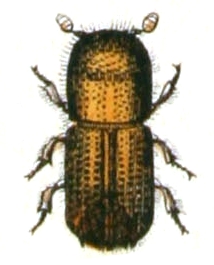Crooked-toothed pine bark beetle
| Crooked-toothed pine bark beetle | ||||||||||||
|---|---|---|---|---|---|---|---|---|---|---|---|---|

Illustration from Calwer's Beetle Book |
||||||||||||
| Systematics | ||||||||||||
|
||||||||||||
| Scientific name | ||||||||||||
| Pityoct of curvidens | ||||||||||||
| ( Germar , 1824) |
The Krummzähnige fir bark beetle ( Pityokteines curvidens , Syn. : Ips curvidens ), also Krummzähniger silver fir bark beetle called, is a European bark beetle from the genus of Pityokteines within the family of weevils (Curculionidae).
description
Adult male beetles are between 2.7 and 3.2 millimeters and female beetles between 2.0 and 2.6 millimeters long. The body is cylindrical in shape, glossy brown in color and densely covered with hair. The hair is slightly longer on the abdomen than on the head. The feelers are yellow. There are three teeth on the fall of the Elytres . The first tooth is bent upwards in the male, the other two are bent like a hook and point to each other. The teeth are smaller in the females. The German species name is derived from these curved teeth. The small eggs are whitish in color. The larvae are around 8 millimeters long.
distribution
The main distribution of the crooked pine bark beetle is in Central, Southern and Eastern Europe.
Way of life
The species mainly attacks fir species ( Abies ). It also attacks the Lebanon cedar ( Cedrus libani ), the European larch ( Larix decidua ), the Norway spruce ( Picea abies ), the Weymouth pine ( Pinus strobus ), the Scots pine ( Pinus sylvestris ) and Pseudotsuga taxifolia less often . The male creates a ramming chamber in the bark , from which the female digs two mother tunnels about 5 to 10 centimeters long, downwards and upwards. These mother tunnels split into two arms at the ends. The larvae hatch about 2 weeks after the eggs are laid. The larvae eat around 7 centimeters long passages in the bark and the sapwood . After around 4 to 5 weeks, the larvae create pupal chambers around 6 millimeters deep in the sapwood. The adult beetles hatch after around two to three weeks. Two, if the conditions are favorable, three generations are trained each year. The first generation flies from late April to May. The second generation flies from July to August. After dry years, mass reproductions can occur. The adult beetles overwinter in the bark of older, living fir trees. If the beetles come across a resin bile, characteristic resin droplets appear on the trunk. The fir trees usually survive this kind of hibernation feed. However, if young trees are often unsuccessfully drilled, the loss of resin can lead to death.
Harmful effect
The crooked pine bark beetle is one of the most dangerous pests for fir trees. Although it normally only attacks weakened and diseased trees, it can also be found on healthy trees during mass reproduction. In infested trees, the bark will peel off and the crown will discolour.
Combat
Felled and diseased trees should be used as quickly as possible or removed from the forest so that there are not enough breeding grounds for the beetle. Trees that cannot be used or removed should be debarked before the larvae have penetrated the wood.
Systematics
The species is regarded as a sister species of the middle pine bark beetle ( Pityokteines vorontzowi ).
swell
- Pityokteines (= Ips) curvidens (Germ.) - Crooked-toothed pine bark beetle ( Memento from July 4, 2008 in the Internet Archive )
- Entry at forestpests.org (English)
- Description at wsl.ch (PDF; 346 kB)
credentials
- ↑ a b c Description at wsl.ch ( page no longer available , search in web archives ) Info: The link was automatically marked as defective. Please check the link according to the instructions and then remove this notice. (PDF; 346 kB)
- ↑ a b c d e entry at Forestpests.org
- ↑ a b c Pityokteines (= Ips) curvidens (Germ.) - Crooked-toothed fir bark beetle ( Memento from July 4, 2008 in the Internet Archive )
- ↑ Milan Pernek, Dimitrios N. Avtzis, Boris Hrašovec, Danko Diminic, Rudolf Wegensteiner, Christian Stauffer and Antony I. Cognato: Novel morphological and genetic markers for the discrimination of three European Pityokteines (Coleoptera: Curculionidae: Scolytinae) species . In: Periodicum Biologorum . tape 110 , no. 4 , 2008, p. 329-334 . Novel morphological and genetic markers for the discrimination of three European Pityokteines (Coleoptera: Curculionidae: Scolytinae) species
